In the world of material handling and heavy lifting, gantry cranes and semi-gantry cranes are two pivotal workhorses. While their names sound similar, their structural designs, capabilities, and ideal applications differ significantly. Understanding these differences is crucial for selecting the right equipment to optimize efficiency, safety, and cost-effectiveness in industrial, construction, and warehouse settings. This article delves into the distinct characteristics, advantages, and use cases of both gantry and semi-gantry cranes.
The core distinction lies in their support structures and mobility.
Gantry Cranes: These are freestanding structures supported by legs that run on floor-mounted rails or wheels. They typically have two sets of legs, forming a complete “bridge” or “gantry” over the load. This design makes them independent of any external building support.

Semi-Gantry Cranes: As the name suggests, they are a hybrid design. One side of the bridge is supported by a leg (or legs) that moves on a ground rail or runway. The other side of the bridge is supported by a runway beam attached to the building structure or an elevated track, much like an overhead bridge crane.

This structural difference is the primary factor influencing all their subsequent advantages and limitations.
Gantry cranes offer unparalleled flexibility and are ideal for heavy-duty outdoor applications.
Complete Mobility and Independence: Their self-supporting design allows them to be used anywhere with a suitable foundation, especially outdoors in shipyards, ports for container handling, lumber yards, and large-scale construction sites. They place no stress on the building’s infrastructure.
High Lifting Capacity: Designed for robust applications, especially double-girder gantry cranes, they can handle extremely heavy loads, often ranging from 5 tons up to 150 tons or more for specialized models.
Excellent Accessibility: The open-legged design provides superior access from all sides of the load, simplifying rigging and positioning awkwardly shaped items.
Adaptability to Large Areas: They are perfect for covering vast, open areas where installing fixed runways is impractical or too expensive.
Semi-gantry cranes offer a smart compromise, blending the benefits of both gantry and overhead bridge cranes.
Superior Space Utilization (Compared to Full Gantry): By utilizing the existing building column for support on one side, they require less floor space than a full gantry crane, which needs clear space for both legs. This leads to a less obstructed work area.
Cost-Effectiveness: The semi-gantry design often requires less structural steel and foundational work for the runway on the building-supported side, potentially resulting in a lower initial investment compared to a full gantry system of similar capacity.
Ideal for Specific Layouts: They are perfectly suited for applications where one side of the work area is against a wall or a line of building columns, such as in workshops, loading bays, or storage areas along a facility’s perimeter.
Good Load Capacity: They retain a significant portion of the lifting capacity of full gantry cranes, making them suitable for many heavy-lifting tasks within industrial facilities.
| Feature | Gantry Crane | Semi-Gantry Crane |
|---|---|---|
| Support Structure | Self-supported by legs on both sides. | One side supported by a leg, the other by a building structure. |
| Mobility & Location | Highly mobile; ideal for outdoor use. | Fixed path; best for indoor or covered areas against a wall. |
| Floor Space Usage | Requires clear space for legs; can obstruct floor. | Utilizes building support; generally less floor obstruction. |
| Installation Cost | Generally higher due to more structure and groundwork. | Often more economical due to using building support. |
| Load Capacity | Very high (e.g., 5 tons to 150+ tons). | High, but may be less than a full gantry of equivalent size. |
| Typical Use Case | Shipyards, container terminals, open storage yards. | Workshops, warehouses, loading bays, fabrication shops. |
Selecting the right crane depends on a thorough analysis of your needs:
Location (Indoor vs. Outdoor): This is the primary deciding factor. For outdoor applications, a full gantry crane is almost always the necessary choice. For indoor applications where one side can be anchored to the building, a semi-gantry crane is often sufficient and more efficient.
Required Floor Space: If maximizing clear, unobstructed floor space is a critical priority (e.g., for forklift traffic), the semi-gantry’s design is advantageous. If the work is in an open area where legs aren’t a hindrance, a full gantry works well.
Load Weight and Span: For the very heaviest loads and extremely wide spans, a robust double-girder gantry crane is typically required9. Semi-gantry cranes are better for moderate to heavy loads within a specific bay width.
Budget Considerations: Evaluate both the initial investment and long-term value. While a semi-gantry might have a lower initial cost, a full gantry’s complete independence could offer more long-term flexibility for layout changes.
Conclusion
There is no universal “best” crane—only the best crane for your specific operational requirements, facility layout, and budget.
Gantry Cranes are the champions of outdoor mobility and heavy-lifting independence, excelling where no overhead support exists.
Semi-Gantry Cranes are the masters of efficient space utilization indoors, providing a powerful and often more economical lifting solution where building support is available on one side.
By carefully weighing the distinct differences and advantages outlined above, you can make an informed decision that enhances safety, boosts productivity, and provides an optimal return on investment for your material handling operations.